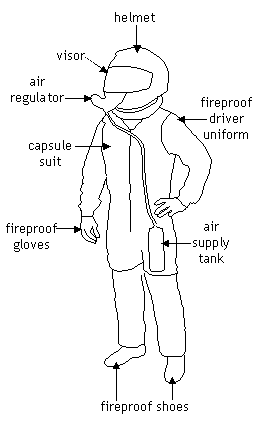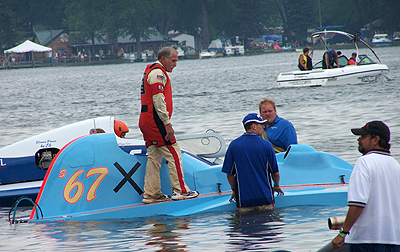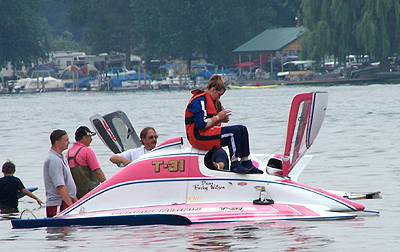 Inboard Hydroplane Racing |
Drivers

Safety Equipment |
|
|
As stated in Accidents, drivers are encased in a protective safety capsule made of a Kevlar composite material that is almost impenetrable. They wear a helmet and capsule suit providing additional protection to the torso. Drivers are restrained with a 5 point safety harness like those used in other motorsports. Although not required, many drivers are equipped with an air supply and breathing mask that is worn throughout the race. In some cases, the breathing apparatus is built into the helmet. The visor acts like a diving mask. The helmet has a valve on it that allows the driver to breath the natural air in the cockpit. When the valve senses water in the cockpit, it switches to allow the driver to breath from the air supply tank. In other cases, the breathing apparatus uses separate breathing mask more like those worn by jet fighter pilots with the air supply tank built into the boat. Helmets also may contain headphones and microphone for the radio system. The radio systems are used by the crew chief to relay information to the driver, like what other boats are around, the time on the clock, when it is clear (4 boat lengths) to get over, etc. Capsule suits are made of Cordura Ballistic Nylon.
They are padded with |
 |
Diverse Ageless SportThough not the ages of the drivers shown here, drivers vary from 14 to 82 years old. Generally they are spread throughout that age range and are a mixture of both sexes. It is truly an ageless sport. Women are just as competitive and professional as the men and hold many championship titles. One of the reasons for so many women competing is that old boat racers had daughters and granddaughters. These women grew up racing in professional racing families. Such a diversity of competitive professionals ready to assist each other when needed is rare indeed. |
|
 |
 |
Driver Qualifications*Inboard racing members who intend to drive racing boats and inboard riding mechanics must submit a statement of good health, certified by either a licensed FAA or D.O.T. physician. The original or a photocopy of this current FAA Class I, II or III, or D.O.T. medical certificate, with no waivers except for corrective lenses, must be sent to APBA headquarters with membership application. If corrective lenses are listed on the medical certificate, they must be used in competition. New drivers shall be designated “Unqualified Rookie” until all provisions of these rules have been met. After completion of these qualification requirements, a new driver shall be designated “Qualified Rookie” for the remainder of his first season. New drivers must be given a written open book examination, followed by an oral review of said examination by the referee or an Inboard Commissioner. He shall show knowledge of course safety and racing rules before being approved to enter the race course. New drivers shall tape or paint a one inch (1”) wide white cross on their helmet for a period of one calendar year. The cross shall extend from the front, up over the top of the helmet to the back rim of the helmet, and from left ear, up over the top of the helmet to the right ear. Rookie drivers in reinforced cockpits, whose helmets are not readily visible, must put the rookie “X” on the cockpit or canopy as near the driver’s head as possible, without obstructing his vision. The “X” may be taped or painted on and must be at least 12” long and 1” wide on both sides of the hull in a color strongly contrasting the color behind it. A new driver shall run four heats, starting at the rear of the pack and advancing only to a position predetermined by the referee. After successfully completing the first 4-heat requirement, a new driver shall run four (4) additional heats advancing only to a position predetermined by the referee. The new driver may only start in the farthest outside position during these heats. To become fully qualified to race, the new driver must get signatures from four (4) qualified drivers in his/her class and at least one referee he/she has raced under. Capsule Training*All drivers and riders of Inboard boats with restraint capsules are required to successfully complete an APBA Approved Inboard Capsule Training Program. Training programs will be approved by the Inboard Racing Commission and conducted by an approved APBA Inboard Rescue Team. The driver will:
|
|
| *These sections are excerpts are from the 2011 APBA Rules for Inboard Racing. | |













